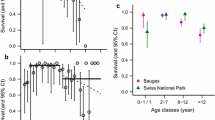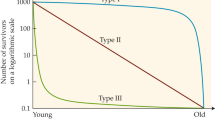Abstract
Recent field studies suggest that it is common in nature for animals to outlive their reproductive viability. Post-reproductive life span has been observed in a broad range of vertebrate and invertebrate species. But post-reproductive life span poses a paradox for traditional theories of life history evolution. The commonly cited explanation is the “grandmother hypothesis”, which applies only to higher, social mammals. We propose that post-reproductive life span evolves to stabilize predator-prey population dynamics, avoiding local extinctions. In the absence of senescence, juveniles would be the most susceptible age class. If juveniles are the first to disappear when predation pressure is high, this amplifies the population’s risk of extinction. A class of older, senescent individuals can help shield the juveniles from predation, stabilizing demographics and avoiding extinction. If, in addition, the life history is arranged so that the older individuals are no longer fertile, the stabilizing effect is further enhanced.
Similar content being viewed by others
References
McAuliffe, K., and Whitehead, H. (2005) Trends Ecol. Evol., 20, 650.
Packer, C., Tatar, M., and Collins, A. (1998) Nature, 392, 807–811.
Austad, S. (1993) J. Zool. London, 229, 695–708.
Ottinger, M. A., and Balthazart, J. (1986) Horm. Behav., 20, 83–94.
Holmes, D. J., and Ottinger, M. A. (2003) Exp. Gerontol., 38, 1365–1375.
Reznick, D., Bryant, M., and Holmes, D. (2006) PLoS Biol., 4, e7.
Gosden, R. G., Laing, S. C., Felicio, L. S., Nelson, J. F., and Finch, C. E. (1983) Biol. Reprod., 28, 255–260.
Goranson, N., Ebersole, J., and Brault, S. (2005) Evol. Ecol. Res., 7, 325–333.
Minois, N., Frajnt, M., Wilson, C., and Vaupel, J. W. (2005) Proc. Natl. Acad. Sci. USA, 102, 402–406.
Cohen, A. A. (2004) Biol. Rev. Camb. Philos. Soc., 79, 733–750.
Lahdenpera, M., Lummaa, V., Helle, S., Tremblay, M., and Russell, A. F. (2004) Nature, 428, 178–181.
Kachel, A. F., Premo, L. S., and Hublin, J. J. (2011) Proc. Biol. Sci., 278, 384–391.
Kirkwood, T. (1977) Nature, 270, 301–304.
Williams, G. (1957) Evolution, 11, 398–411.
Maynard Smith, J. (1976) Q. Rev. Biol., 51, 277–283.
Wilson, D. S. (1997) The American Naturalist, 150(S1), S1–S21.
Price, G. R. (1970) Nature, 227, 520–521.
Wright, S. (1931) Genetics, 16, 97–159.
Gilpin, M. E. (1975) Group Selection in Predator-Prey Communities, Princeton University Press, Princeton.
Mitteldorf, J. (2006) Evol. Ecol. Res., 8, 561–574.
Borrello, M. (2010) Evolutionary Restraints: the Contentious History of Group Selection, University of Chicago Press, Chicago.
Wynne-Edwards, V. (1962) Animal Dispersion in Relation to Social Behavior, Oliver & Boyd, Edinburgh.
May, R. M. (1973) Stability and Complexity in Model Ecosystems, Princeton University Press.
Thomas, W. R., Pomerantz, M. J., and Gilpin, M. E. (1980) Ecology, 61, 1312–1320.
Ferriere, R., and Fox, G. A. (1995) Trends Ecol. Evol., 10, 480–485.
Heckel, D. G., and Roughgarden, J. (1980) Proc. Natl. Acad. Sci. USA, 77, 7497–7500.
Turelli, M., and Petry, D. (1980) Proc. Natl. Acad. Sci. USA, 77, 7501–7505.
Mueller, L. D., and Joshi, A. (2000) Stability in Model Populations. Monographs in Population Biology (Levin, S. A., and Horn, H. S., eds.) Vol. 31, Princeton University Press, Princeton.
Mitteldorf, J. (2004) Evol. Ecol. Res., 6, 1–17.
Mitteldorf, J. (2010) in Approaches to the Control of Aging: Building a Pathway to Human Life Extension (Fahy, G. M., et al., eds.) Springer, New York.
Mitteldorf, J., and Pepper, J. (2004) Selection in Ecosystems, Fifth Int. Conf. on Complex Systems, NECSI, Boston, MA.
Lotka, A. J. (1925) Elements of Physical Biology, Williams and Wilkins, Baltimore.
Volterra, V. (1931) in Animal Ecology (Chapman, R. N., ed.) McGraw-Hill.
Rosenzweig, M. L. (1971) Science, 171, 385–387.
Ricklefs, R. (1998) Am. Nat., 152, 24–44.
Bonduriansky, R., and Brassil, C. E. (2002) Nature, 420, 377.
Bonduriansky, R., and Brassil, C. E. (2005) J. Evol. Biol., 18, 1332–1340.
Nussey, D. H., Froy, H., Lemaitre, J. F., Gaillard, J. M., and Austad, S. N. (2012) Ageing Res. Rev., 12, 214–225.
Nudds, T. (1987) in Wild Furbearer Management and Conservation in North America (Novak, M. B., Obbard, J., M., and Mallock, B., eds.) Ontario Trappers Assn., Toronto.
Rand, D. A., Keeling, M., and Wilson, H. B. (1995) Proc. Roy. Soc. B, 259, 55–63.
Abrams, P. A. (2000) Ann. Rev. Ecol. Sys., 31, 79–105.
Cuddington, K., and Yodzis, P. (2002) Am. Nat., 160, 119–134.
Pels, B., de Roos, A. M., and Sabelis, M. W. (2002) Am. Nat., 159, 172–189.
Pepper, J. W., and Smuts, B. B. (2002) Am. Nat., 160, 205–213.
Rauch, E. M., Sayama, H., and Bar-Yam, Y. (2003) J. Theor. Biol., 221, 655–664.
Loreau, M., and Ebenhoh, W. (1994) Theor. Popul. Biol., 46, 58–77.
Moll, J. D., and Brown, J. S. (2008) Am. Nat., 171, 839–843.
Medawar, P. B. (1952) An Unsolved Problem of Biology, Published for the College by H. K. Lewis, London.
Author information
Authors and Affiliations
Corresponding author
Additional information
Published in Russian in Biokhimiya, 2013, Vol. 78, No. 9, pp. 1293–1305.
Rights and permissions
About this article
Cite this article
Mitteldorf, J.J., Goodnight, C. Post-reproductive life span and demographic stability. Biochemistry Moscow 78, 1013–1022 (2013). https://doi.org/10.1134/S0006297913090071
Received:
Published:
Issue Date:
DOI: https://doi.org/10.1134/S0006297913090071




